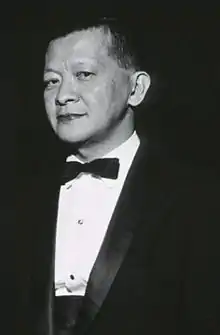Joe Hin Tjio | |
|---|---|
 | |
| Born | 2 November 1919 |
| Died | 27 November 2001 (aged 82) Gaithersburg, Maryland, U.S |
| Alma mater | Bogor Institute of Agriculture |
| Spouse | Inga Bjorg Arna Bildsfell Tjio |
| Children | 1 son |
| Awards | International Prize Award by Joseph P. Kennedy Jr. Foundation |
| Scientific career | |
| Fields | Cytogenetics |
| Institutions | National Institute of Health |
| Joe Hin Tjio | |||||||||||||
|---|---|---|---|---|---|---|---|---|---|---|---|---|---|
| Traditional Chinese | 蔣有興[1] | ||||||||||||
| Simplified Chinese | 蒋有兴 | ||||||||||||
| |||||||||||||
Joe Hin Tjio (/ˈtʃiːoʊ/; 2 November 1919 – 27 November 2001), was an Indonesian-born American cytogeneticist. He was renowned as the first person to recognize the normal number of human chromosomes on December 22, 1955 at the Institute of Genetics of the University of Lund in Sweden, where Tjio was a visiting scientist.
Early life
Tjio was born to Indonesian parents of Chinese origin in Pekalongan, Java, then part of the Dutch East Indies and later known as Indonesia. His father was a photographer. Tjio was educated in Dutch colonial schools, trained in agronomy in college, and did research on potato breeding. He was imprisoned for 3 years and tortured by the Japanese in a concentration camp during World War II.[2]
Career
After the war ended, Tjio went to the Netherlands, whose government provided him with a fellowship for study in Europe. He worked in plant breeding in Denmark, Spain and Sweden. From 1948 to 1959 he did plant chromosome research in Zaragoza in Spain and spent his summers in Sweden working with Professor Albert Levan in Lund.[3]
In 1953, a lab mistake involving mixing HeLa cells with the wrong liquid led Tjio and Levan to develop better techniques for staining and counting chromosomes. It allowed researchers for the first time to see and count each chromosome clearly in the HeLa cells with which they were working. They were the first to show that humans have 23 pairs of chromosomes rather than 24, as was previously believed. This was important for the study of developmental disorders, such as Down syndrome, that involve the number of chromosomes.[4] Tjio made his discovery of the correct human chromosome count (46 chromosomes, rather than 48 as counted in 1921 by Theophilus Painter) in 1955 and the findings were published (with Levan as his co-author) in the Scandinavian journal Hereditas on January 26, 1956.
In 1958 Tjio went to the United States and in 1959 he joined the staff of the National Institutes of Health in Bethesda, Maryland. He received his Ph.D. in biophysics and cytogenetics from the University of Colorado. He spent the balance of his career at the NIH in human chromosome research. He was named scientist emeritus in 1992, but maintained a laboratory for the next five years. In 1997, he retired to Gaithersburg, Maryland.[2]
Works
- Tjio JH, Levan A. The chromosome number of man. Hereditas vol. 42: pages 1–6, 1956.
References
- ↑ 李名揚 (July 2008), 台灣癌症醫療之母 (PDF), 科學人看 (in Chinese (Taiwan)), pp. 86–91, archived from the original (PDF) on 2012-03-28, retrieved 2011-08-03
- 1 2 Saxon, Wolfgang (2001-12-07), "Joe Hin Tjio, 82; Research Biologist Counted Chromosomes", The New York Times, retrieved 2011-08-03
- ↑ McManus, Rich (1997-02-11), "Photographer, Prisoner, Polyglot: NIDDK's Tjio Ends Distinguished Scientific Career", The NIH Record, 46 (3), archived from the original on 2011-07-21, retrieved 2011-08-03
- ↑ MacDonald, Anna (13 June 2018). "5 Contributions HeLa Cells Have Made to Science". Cell Science from Technology Networks. Retrieved 2020-03-25.
External links
- Human chromosome count in MedTerms Medical Dictionary